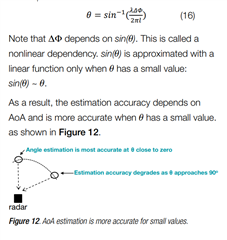Other Parts Discussed in Thread: IWR6843
I think I have an understanding problem.
For the IWR6834AOPEVM, if all antennas are used then the azimuth/elevation resolution should be 30 deg, given this sensor has 120x120 FOV this means that the FOV is discretized in a 5x5 grid right?
I was curious if it is possible for multiple points to have the same value for azimuth/elevation but different values of range and doppler. If the previous statement is correct I feel this must be the case, because the point clouds certainly don't seem to max out at 16 points. But intuitively two reflection at the same azimuth/elevation should mean that one is shadowed by the other right?
Hopefully you can shed some light on this.
Just to be sure, angular resolution in this context does mean that a point's azimuth and elevation has to be one of the following values:
- -60
- -30
- 0
- 30
- 60



